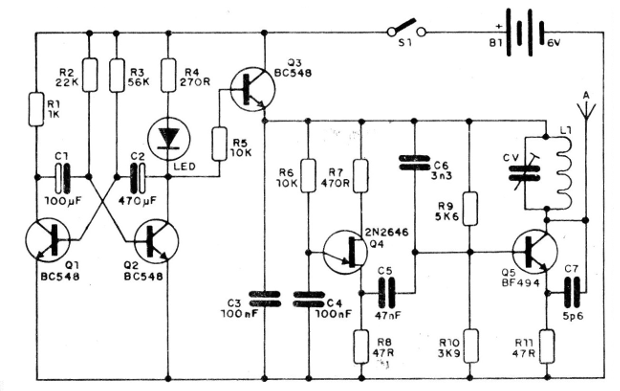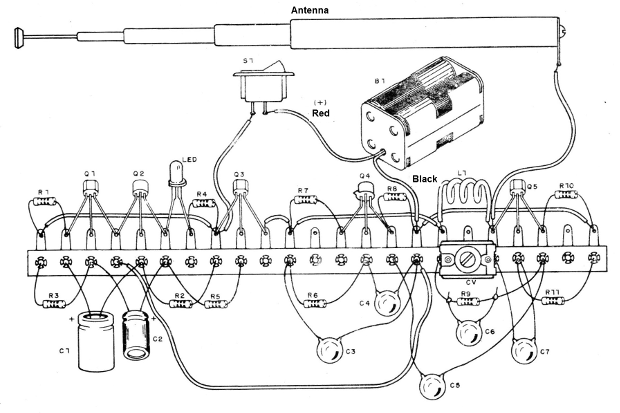Usually a mobile station is used, installed in a car, for example, which tries to escape from the pursuers, but stops every once in a while to transmit messages.
The pursuers, armed with radios in their cars, should seek to locate the "fox" based only on their signals, issued at times and frequencies combined. Those who locate the fox first win the contest.
Our game is made on a small scale and can be very interesting if it is put into practice in a park or in a large house.
The fox is a transmitter which at regular intervals emits a continuous whistle that lasts for a few seconds. This transmitter is small enough to be installed in a hidden box.
Using portable FM radios, trackers should locate the fox, i.e., the transmitter.
Whoever can do it in the first place wins the contest.
An idea would be to build the transmitter in a box larger than the usual, so the "prize" can take place in it, which could be a good amount of candy!
What is interesting in the game is that the transmitter has a limited radius of action, which means that, first of all, we should try to reach a minimum distance to start listening to its signals and then just go looking for it when this signal becomes hotter or "colder".
HOW IT WORKS
The device is very simple in its structure. We initially have a time circuit which turns the system on and off at regular intervals.
The capacitors of the multivibrator C1 and C2 determine the time intervals. One of them, the smaller one, determines the transmission time and the bigger determines the interval between the transmissions.
Readers may alter these components to make it easier or more difficult for the hunters to find the device.
In this time circuit there is an LED that monitors the action of the system, which is especially interesting when adjusting the operating frequency.
The time circuit drives the transmitting step consisting of an audio oscillator (modulator) and an FM oscillator.
The audio oscillator uses a unijunction transistor whose frequency depends on the resistor and capacitor connected to its emitter. Different shades can be achieved by simply changing the resistor. Smaller values ??allow you to get higher and deeper sounds.
The FM oscillator is based on a transistor BF494 or equivalent, operating at a frequency determined by CV and L1. A free frequency of the FM band is chosen in CV, since portable receivers of FM are more common and everybody can use in the game easily. FM radios, walkmans and even cars can be used on the hunt!
The unit is powered by 4 small alkaline batteries which can be connected for hours, long enough for the game to be played more than once.
The antenna consists of a piece of wire of 15 to 20 cm, which allows the radiation of the signal reach distances of more than 50 meters. We get a circle of about 50 meters radius where the hunters must penetrate to begin capturing the signals.
ASSEMBLY
In Figure 1 we have the complete circuit of the apparatus.

The accomplishment of the assembly in terminal strips is possible and its drawing is given in Figure 2.

For those who want the printed circuit board version we offer a suggestion in Figure 3.

In addition to the usual care with positions and polarity of the components we have some important recommendations that must be followed to ensure the proper functioning of the system.
A) The transistors Q1, Q2 and Q3 must be BC548 or equivalent. But Q4 should be unijunction 2N2646 and Q5 a BF494 or BF495.
B) L1 is formed by 3 or 4 turns of common thread wound on a pencil which is removed afterwards. The CV trimmer capacitor can be just about any trimmer.
C) The resistors are 1/8 W or ¼ W depending on the availability of the assembler.
D) The electrolytic capacitors can have voltages from 6 V and their values ??are flexible. Try close values if you do not have the originals.
E) The other capacitors must be of good quality ceramic, especially the ones close to Q5.
F) The antenna is simply a piece of rigid wire which must be upright in the operation. Its length is between 15 and 20 cm.
Install the unit in a box so that it can be placed in a concealed place, along with prizes or gifts.
TEST AND USE
Insert the batteries into the holder and connect a nearby FM receiver to a fre- quency of about 100 MHz.
Adjust the trimmer until it picks up the signal from the transmitter. Remember that the emission only occurs at the time the LED goes off. If you want to make the emission constant, you need to temporarily connect a 1 k resistor between the collector and the Q3 base.
Try to tune it in the strongest signal, since it may pick up signals at more than one point of the setting.
Once the operation has been checked, check its range by moving it away from the receiver. As you step away, retouch the receiver's tune so you can track the signal better.
Then just play, which will be done as follows:
A) Hide the transmitter that must be connected to the antenna in an upright position.
B) Agree that each participant in the game should bring their portable FM radio.
C) Explain that there is a hidden transmitter (which is the fox) and that each must find it by the signal it emits. Indicate the frequency it is operating.
D) Start the game, preferably at a point where it is initially out of range of the transmitter. This way the game will have two stages: first to locate the signal and then the transmitter itself.
Tip: Note that the signal strength is higher at a certain position on your radio. Based on this positioning you can determine the direction from which the signal comes, facilitating the location of the transmitter.
Q1, Q2, Q3 - BC548 or equivalent - general purpose NPN transistors
Q4 - 2N2646 - unijunction transistor
Q5 - BF494 or BF495 - RF transistor
L1 - 3 to 4 turns of common wire (see text)
CV - common trimmer
S1 - single switch
R1 - 1 k - resistor (brown, black, red)
R2 - 22k - resistor (red, red, orange)
R3 - 56 k - resistor (green, blue, orange)
R4 - 270 ohms - resistor (red, violet, brown)
R5, R6 - 10 k - resistor (brown, black, orange)
R7 - 470 ohms - resistor (yellow, violet, brown)
R8 - 47 ohms - resistor (yellow, violet, black)
R9 - 5k6 - resistor (green, blue, red)
R10 - 3k9 - resistor (orange, white, red)
R11 - 47 ohms - resistor (yellow, violet, black)
C1 - 100 uF - electrolytic capacitor
C2 - 470 uF - electrolytic capacitor
C3, C4-100 nF (104) - ceramic capacitor
C5-47 nF (473) - ceramic capacitor
C6 - 3n3 (332) - ceramic capacitor
C7 - 5p6 - ceramic capacitor
LED - Common red LED
B1 - 6 V - 4 small alkaline batteries
Miscellaneous: terminal bridge or printed circuit board, 4 battery holder, antennas, mounting box, wire, welder, etc.
Revised 2017



